Knowledge Management & E-commerce
VerifiedAdded on 2019/11/26
|8
|2053
|157
Essay
AI Summary
This essay examines the application of knowledge management (KM) in a youth fashion clothing store startup located in Sydney's Pitt St Mall. It analyzes the importance of KM in establishing partnerships, operations, and overall business success. The essay discusses both internal and external KM strategies, including sourcing knowledge, assessing strengths and weaknesses, knowledge sharing techniques, and adapting to the rapidly changing fashion trends. Internal KM focuses on utilizing information for effective marketing, inventory management, and creating a strong organizational culture. External KM emphasizes staying updated on global and local fashion trends through interactions with various sources, including fashion shows and magazines. The essay concludes that a well-implemented KM strategy is crucial for the startup's growth and expansion within Australia.
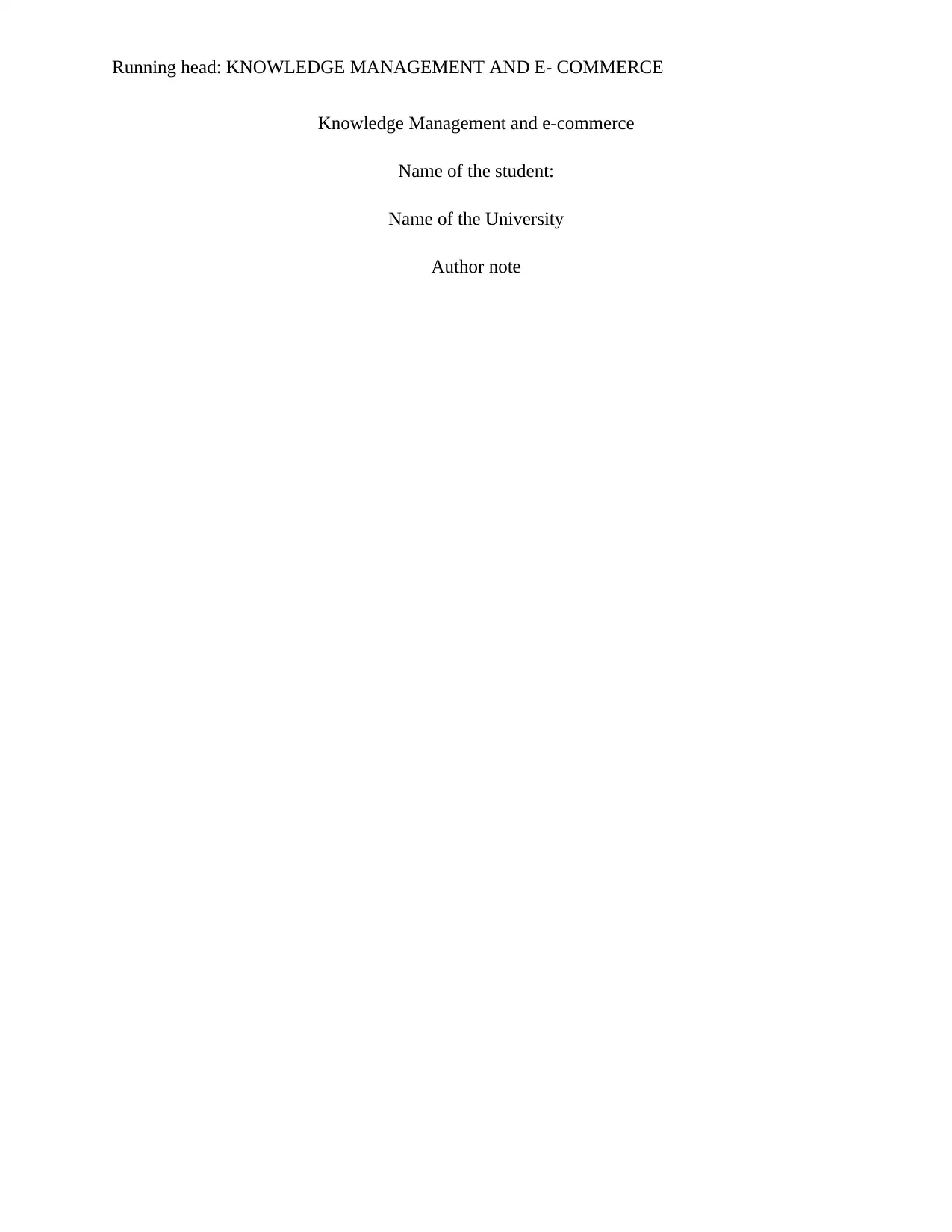
Running head: KNOWLEDGE MANAGEMENT AND E- COMMERCE
Knowledge Management and e-commerce
Name of the student:
Name of the University
Author note
Knowledge Management and e-commerce
Name of the student:
Name of the University
Author note
Paraphrase This Document
Need a fresh take? Get an instant paraphrase of this document with our AI Paraphraser
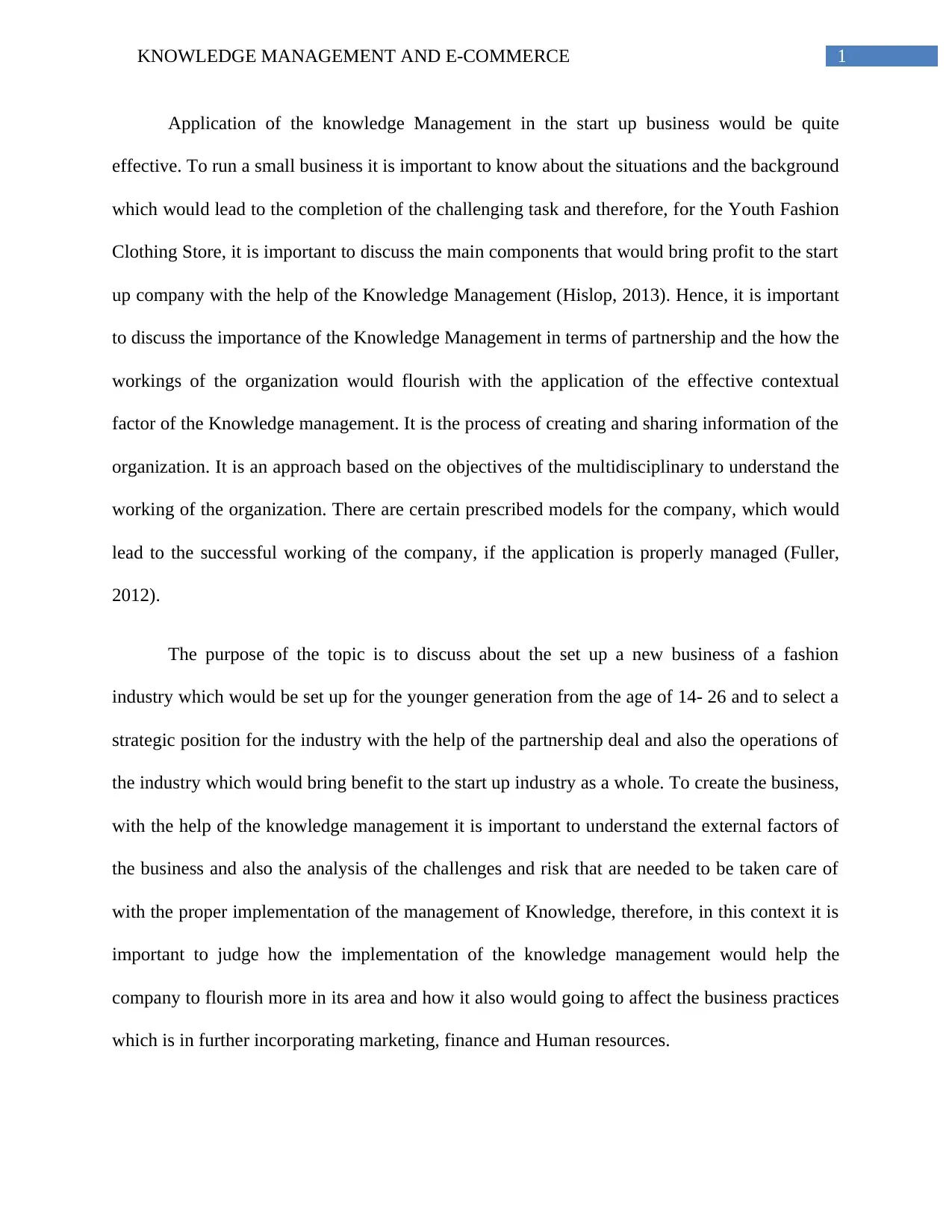
1KNOWLEDGE MANAGEMENT AND E-COMMERCE
Application of the knowledge Management in the start up business would be quite
effective. To run a small business it is important to know about the situations and the background
which would lead to the completion of the challenging task and therefore, for the Youth Fashion
Clothing Store, it is important to discuss the main components that would bring profit to the start
up company with the help of the Knowledge Management (Hislop, 2013). Hence, it is important
to discuss the importance of the Knowledge Management in terms of partnership and the how the
workings of the organization would flourish with the application of the effective contextual
factor of the Knowledge management. It is the process of creating and sharing information of the
organization. It is an approach based on the objectives of the multidisciplinary to understand the
working of the organization. There are certain prescribed models for the company, which would
lead to the successful working of the company, if the application is properly managed (Fuller,
2012).
The purpose of the topic is to discuss about the set up a new business of a fashion
industry which would be set up for the younger generation from the age of 14- 26 and to select a
strategic position for the industry with the help of the partnership deal and also the operations of
the industry which would bring benefit to the start up industry as a whole. To create the business,
with the help of the knowledge management it is important to understand the external factors of
the business and also the analysis of the challenges and risk that are needed to be taken care of
with the proper implementation of the management of Knowledge, therefore, in this context it is
important to judge how the implementation of the knowledge management would help the
company to flourish more in its area and how it also would going to affect the business practices
which is in further incorporating marketing, finance and Human resources.
Application of the knowledge Management in the start up business would be quite
effective. To run a small business it is important to know about the situations and the background
which would lead to the completion of the challenging task and therefore, for the Youth Fashion
Clothing Store, it is important to discuss the main components that would bring profit to the start
up company with the help of the Knowledge Management (Hislop, 2013). Hence, it is important
to discuss the importance of the Knowledge Management in terms of partnership and the how the
workings of the organization would flourish with the application of the effective contextual
factor of the Knowledge management. It is the process of creating and sharing information of the
organization. It is an approach based on the objectives of the multidisciplinary to understand the
working of the organization. There are certain prescribed models for the company, which would
lead to the successful working of the company, if the application is properly managed (Fuller,
2012).
The purpose of the topic is to discuss about the set up a new business of a fashion
industry which would be set up for the younger generation from the age of 14- 26 and to select a
strategic position for the industry with the help of the partnership deal and also the operations of
the industry which would bring benefit to the start up industry as a whole. To create the business,
with the help of the knowledge management it is important to understand the external factors of
the business and also the analysis of the challenges and risk that are needed to be taken care of
with the proper implementation of the management of Knowledge, therefore, in this context it is
important to judge how the implementation of the knowledge management would help the
company to flourish more in its area and how it also would going to affect the business practices
which is in further incorporating marketing, finance and Human resources.
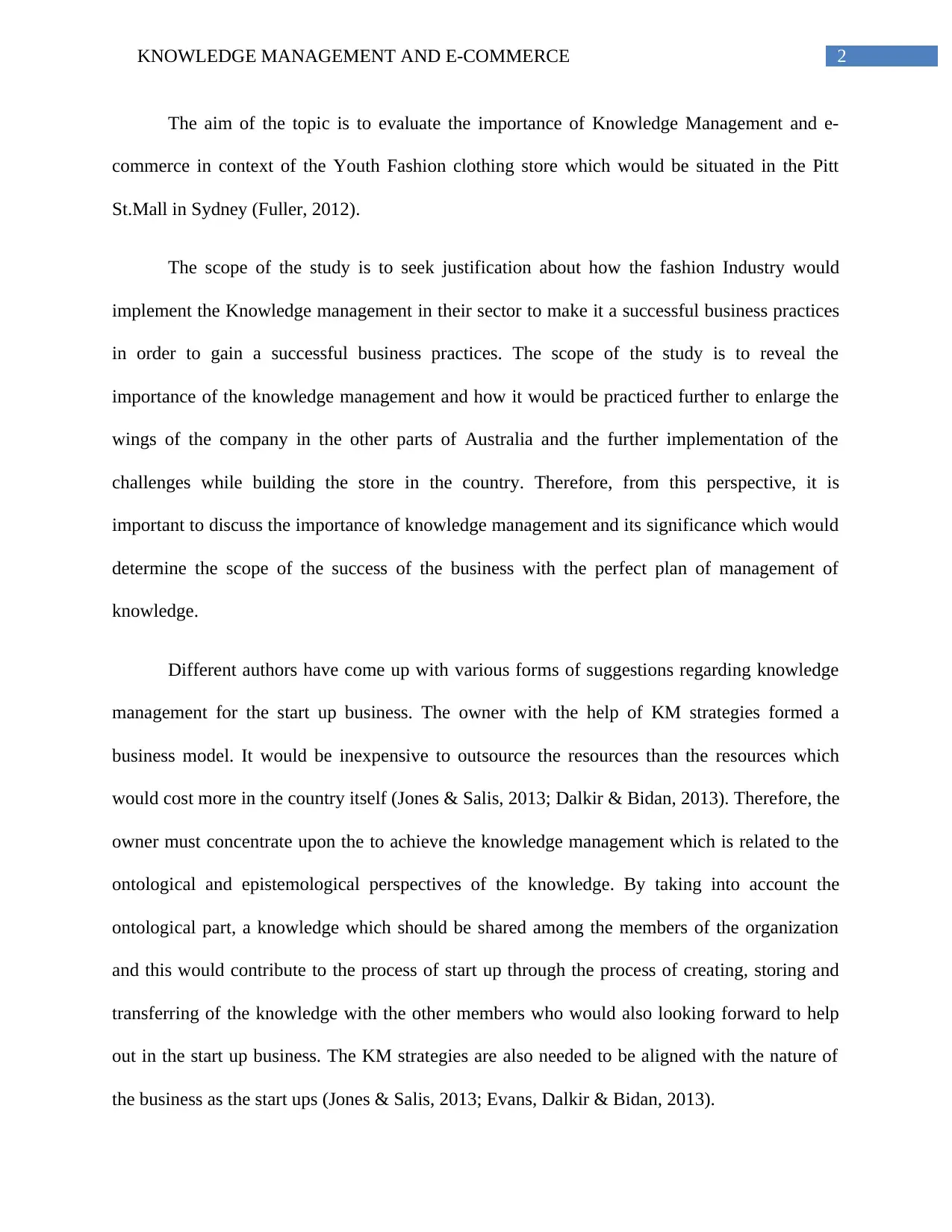
2KNOWLEDGE MANAGEMENT AND E-COMMERCE
The aim of the topic is to evaluate the importance of Knowledge Management and e-
commerce in context of the Youth Fashion clothing store which would be situated in the Pitt
St.Mall in Sydney (Fuller, 2012).
The scope of the study is to seek justification about how the fashion Industry would
implement the Knowledge management in their sector to make it a successful business practices
in order to gain a successful business practices. The scope of the study is to reveal the
importance of the knowledge management and how it would be practiced further to enlarge the
wings of the company in the other parts of Australia and the further implementation of the
challenges while building the store in the country. Therefore, from this perspective, it is
important to discuss the importance of knowledge management and its significance which would
determine the scope of the success of the business with the perfect plan of management of
knowledge.
Different authors have come up with various forms of suggestions regarding knowledge
management for the start up business. The owner with the help of KM strategies formed a
business model. It would be inexpensive to outsource the resources than the resources which
would cost more in the country itself (Jones & Salis, 2013; Dalkir & Bidan, 2013). Therefore, the
owner must concentrate upon the to achieve the knowledge management which is related to the
ontological and epistemological perspectives of the knowledge. By taking into account the
ontological part, a knowledge which should be shared among the members of the organization
and this would contribute to the process of start up through the process of creating, storing and
transferring of the knowledge with the other members who would also looking forward to help
out in the start up business. The KM strategies are also needed to be aligned with the nature of
the business as the start ups (Jones & Salis, 2013; Evans, Dalkir & Bidan, 2013).
The aim of the topic is to evaluate the importance of Knowledge Management and e-
commerce in context of the Youth Fashion clothing store which would be situated in the Pitt
St.Mall in Sydney (Fuller, 2012).
The scope of the study is to seek justification about how the fashion Industry would
implement the Knowledge management in their sector to make it a successful business practices
in order to gain a successful business practices. The scope of the study is to reveal the
importance of the knowledge management and how it would be practiced further to enlarge the
wings of the company in the other parts of Australia and the further implementation of the
challenges while building the store in the country. Therefore, from this perspective, it is
important to discuss the importance of knowledge management and its significance which would
determine the scope of the success of the business with the perfect plan of management of
knowledge.
Different authors have come up with various forms of suggestions regarding knowledge
management for the start up business. The owner with the help of KM strategies formed a
business model. It would be inexpensive to outsource the resources than the resources which
would cost more in the country itself (Jones & Salis, 2013; Dalkir & Bidan, 2013). Therefore, the
owner must concentrate upon the to achieve the knowledge management which is related to the
ontological and epistemological perspectives of the knowledge. By taking into account the
ontological part, a knowledge which should be shared among the members of the organization
and this would contribute to the process of start up through the process of creating, storing and
transferring of the knowledge with the other members who would also looking forward to help
out in the start up business. The KM strategies are also needed to be aligned with the nature of
the business as the start ups (Jones & Salis, 2013; Evans, Dalkir & Bidan, 2013).
⊘ This is a preview!⊘
Do you want full access?
Subscribe today to unlock all pages.

Trusted by 1+ million students worldwide
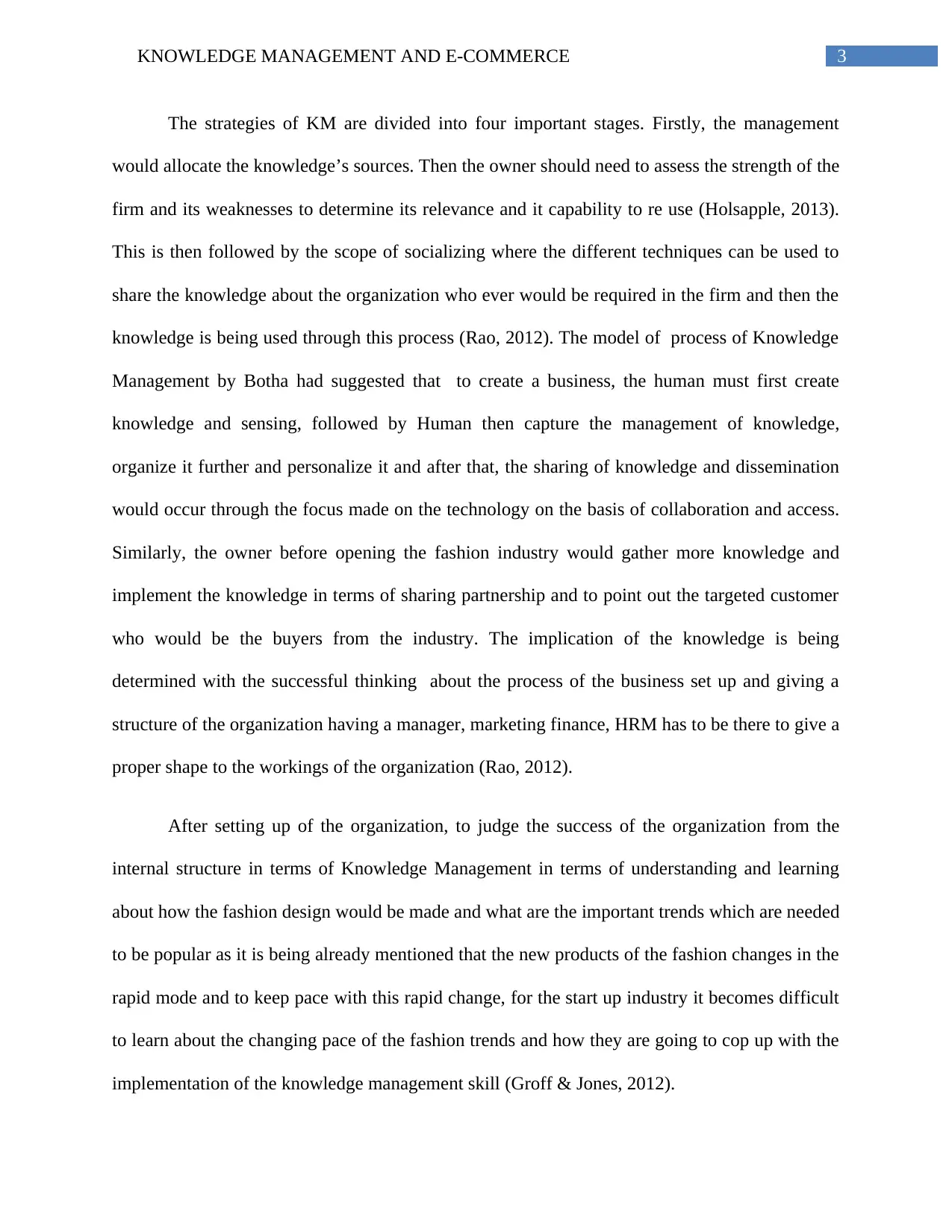
3KNOWLEDGE MANAGEMENT AND E-COMMERCE
The strategies of KM are divided into four important stages. Firstly, the management
would allocate the knowledge’s sources. Then the owner should need to assess the strength of the
firm and its weaknesses to determine its relevance and it capability to re use (Holsapple, 2013).
This is then followed by the scope of socializing where the different techniques can be used to
share the knowledge about the organization who ever would be required in the firm and then the
knowledge is being used through this process (Rao, 2012). The model of process of Knowledge
Management by Botha had suggested that to create a business, the human must first create
knowledge and sensing, followed by Human then capture the management of knowledge,
organize it further and personalize it and after that, the sharing of knowledge and dissemination
would occur through the focus made on the technology on the basis of collaboration and access.
Similarly, the owner before opening the fashion industry would gather more knowledge and
implement the knowledge in terms of sharing partnership and to point out the targeted customer
who would be the buyers from the industry. The implication of the knowledge is being
determined with the successful thinking about the process of the business set up and giving a
structure of the organization having a manager, marketing finance, HRM has to be there to give a
proper shape to the workings of the organization (Rao, 2012).
After setting up of the organization, to judge the success of the organization from the
internal structure in terms of Knowledge Management in terms of understanding and learning
about how the fashion design would be made and what are the important trends which are needed
to be popular as it is being already mentioned that the new products of the fashion changes in the
rapid mode and to keep pace with this rapid change, for the start up industry it becomes difficult
to learn about the changing pace of the fashion trends and how they are going to cop up with the
implementation of the knowledge management skill (Groff & Jones, 2012).
The strategies of KM are divided into four important stages. Firstly, the management
would allocate the knowledge’s sources. Then the owner should need to assess the strength of the
firm and its weaknesses to determine its relevance and it capability to re use (Holsapple, 2013).
This is then followed by the scope of socializing where the different techniques can be used to
share the knowledge about the organization who ever would be required in the firm and then the
knowledge is being used through this process (Rao, 2012). The model of process of Knowledge
Management by Botha had suggested that to create a business, the human must first create
knowledge and sensing, followed by Human then capture the management of knowledge,
organize it further and personalize it and after that, the sharing of knowledge and dissemination
would occur through the focus made on the technology on the basis of collaboration and access.
Similarly, the owner before opening the fashion industry would gather more knowledge and
implement the knowledge in terms of sharing partnership and to point out the targeted customer
who would be the buyers from the industry. The implication of the knowledge is being
determined with the successful thinking about the process of the business set up and giving a
structure of the organization having a manager, marketing finance, HRM has to be there to give a
proper shape to the workings of the organization (Rao, 2012).
After setting up of the organization, to judge the success of the organization from the
internal structure in terms of Knowledge Management in terms of understanding and learning
about how the fashion design would be made and what are the important trends which are needed
to be popular as it is being already mentioned that the new products of the fashion changes in the
rapid mode and to keep pace with this rapid change, for the start up industry it becomes difficult
to learn about the changing pace of the fashion trends and how they are going to cop up with the
implementation of the knowledge management skill (Groff & Jones, 2012).
Paraphrase This Document
Need a fresh take? Get an instant paraphrase of this document with our AI Paraphraser
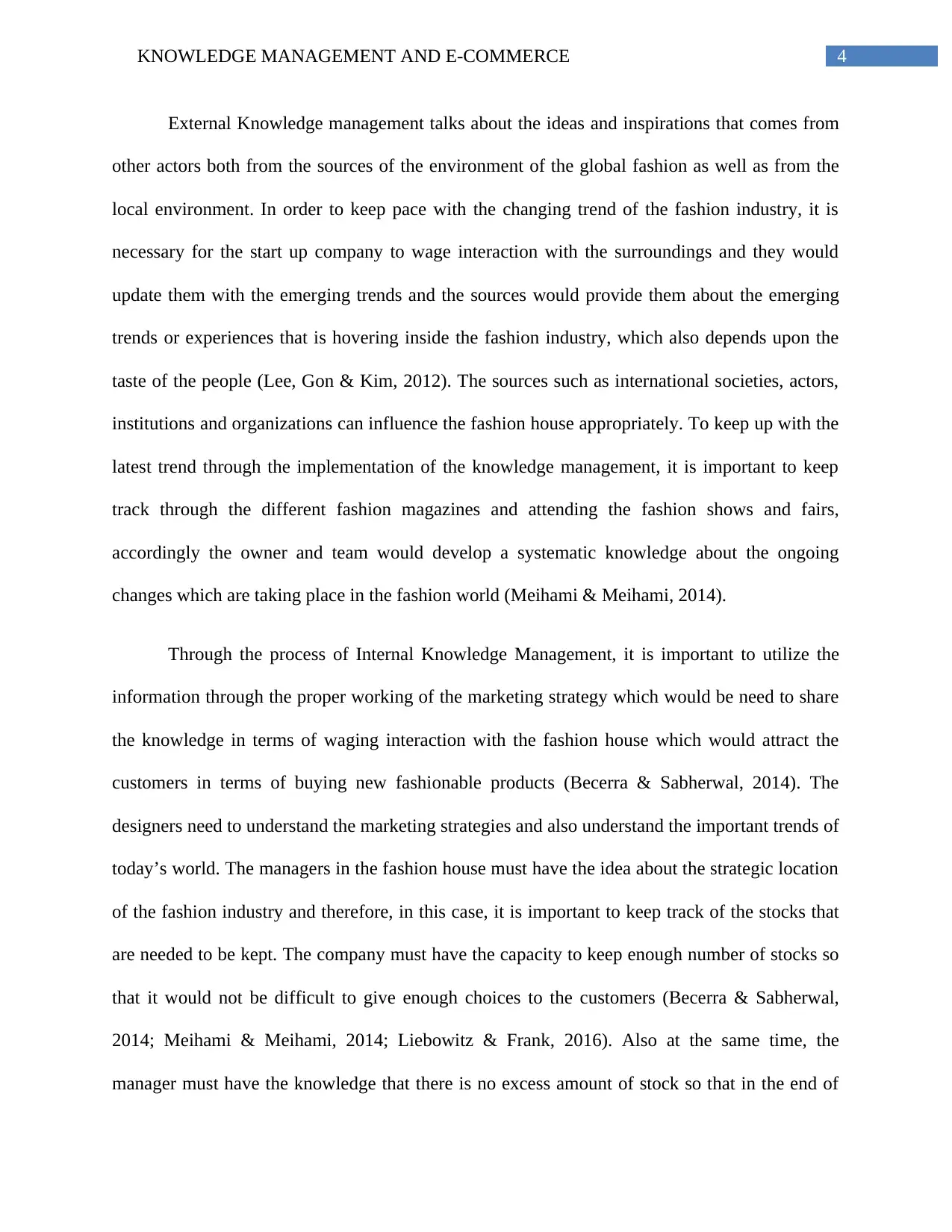
4KNOWLEDGE MANAGEMENT AND E-COMMERCE
External Knowledge management talks about the ideas and inspirations that comes from
other actors both from the sources of the environment of the global fashion as well as from the
local environment. In order to keep pace with the changing trend of the fashion industry, it is
necessary for the start up company to wage interaction with the surroundings and they would
update them with the emerging trends and the sources would provide them about the emerging
trends or experiences that is hovering inside the fashion industry, which also depends upon the
taste of the people (Lee, Gon & Kim, 2012). The sources such as international societies, actors,
institutions and organizations can influence the fashion house appropriately. To keep up with the
latest trend through the implementation of the knowledge management, it is important to keep
track through the different fashion magazines and attending the fashion shows and fairs,
accordingly the owner and team would develop a systematic knowledge about the ongoing
changes which are taking place in the fashion world (Meihami & Meihami, 2014).
Through the process of Internal Knowledge Management, it is important to utilize the
information through the proper working of the marketing strategy which would be need to share
the knowledge in terms of waging interaction with the fashion house which would attract the
customers in terms of buying new fashionable products (Becerra & Sabherwal, 2014). The
designers need to understand the marketing strategies and also understand the important trends of
today’s world. The managers in the fashion house must have the idea about the strategic location
of the fashion industry and therefore, in this case, it is important to keep track of the stocks that
are needed to be kept. The company must have the capacity to keep enough number of stocks so
that it would not be difficult to give enough choices to the customers (Becerra & Sabherwal,
2014; Meihami & Meihami, 2014; Liebowitz & Frank, 2016). Also at the same time, the
manager must have the knowledge that there is no excess amount of stock so that in the end of
External Knowledge management talks about the ideas and inspirations that comes from
other actors both from the sources of the environment of the global fashion as well as from the
local environment. In order to keep pace with the changing trend of the fashion industry, it is
necessary for the start up company to wage interaction with the surroundings and they would
update them with the emerging trends and the sources would provide them about the emerging
trends or experiences that is hovering inside the fashion industry, which also depends upon the
taste of the people (Lee, Gon & Kim, 2012). The sources such as international societies, actors,
institutions and organizations can influence the fashion house appropriately. To keep up with the
latest trend through the implementation of the knowledge management, it is important to keep
track through the different fashion magazines and attending the fashion shows and fairs,
accordingly the owner and team would develop a systematic knowledge about the ongoing
changes which are taking place in the fashion world (Meihami & Meihami, 2014).
Through the process of Internal Knowledge Management, it is important to utilize the
information through the proper working of the marketing strategy which would be need to share
the knowledge in terms of waging interaction with the fashion house which would attract the
customers in terms of buying new fashionable products (Becerra & Sabherwal, 2014). The
designers need to understand the marketing strategies and also understand the important trends of
today’s world. The managers in the fashion house must have the idea about the strategic location
of the fashion industry and therefore, in this case, it is important to keep track of the stocks that
are needed to be kept. The company must have the capacity to keep enough number of stocks so
that it would not be difficult to give enough choices to the customers (Becerra & Sabherwal,
2014; Meihami & Meihami, 2014; Liebowitz & Frank, 2016). Also at the same time, the
manager must have the knowledge that there is no excess amount of stock so that in the end of
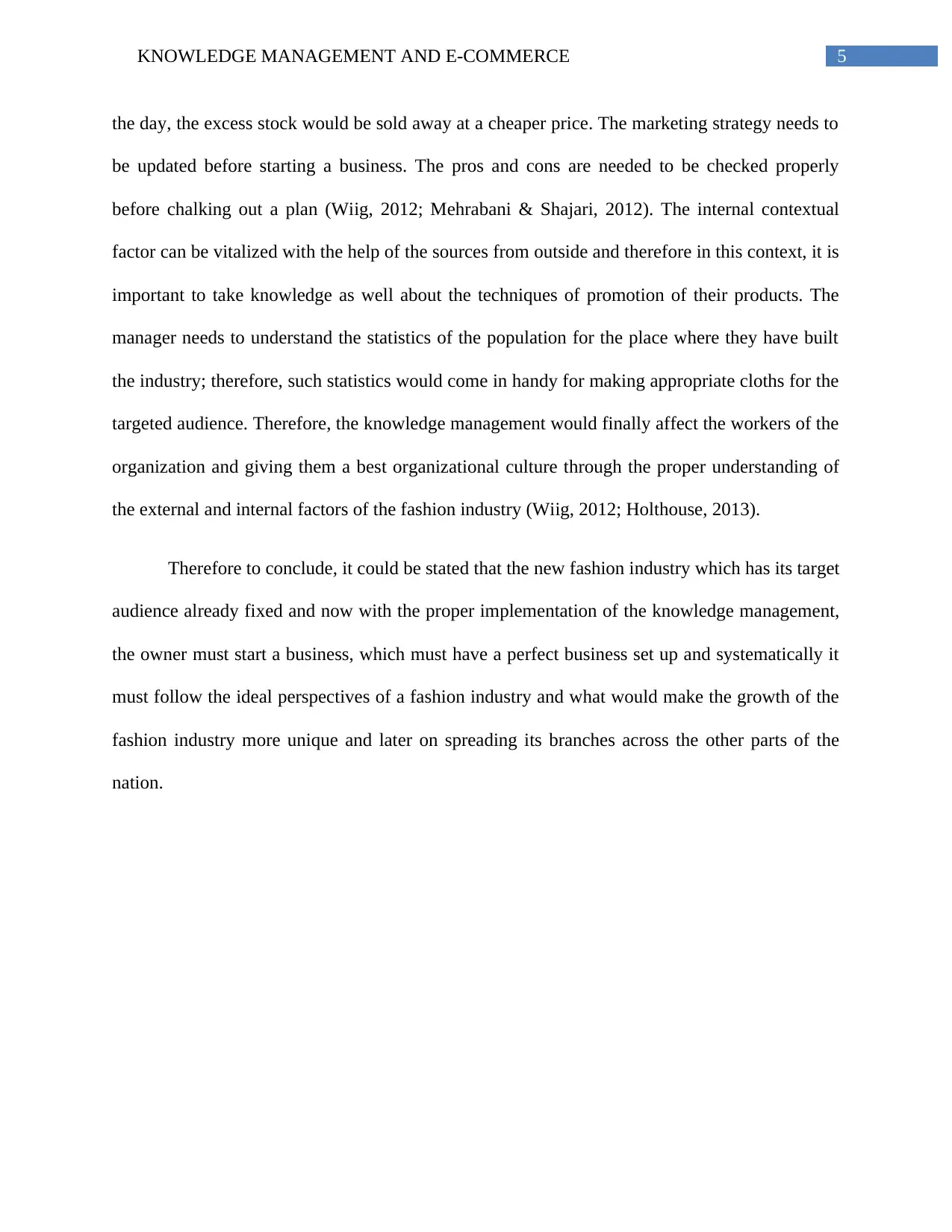
5KNOWLEDGE MANAGEMENT AND E-COMMERCE
the day, the excess stock would be sold away at a cheaper price. The marketing strategy needs to
be updated before starting a business. The pros and cons are needed to be checked properly
before chalking out a plan (Wiig, 2012; Mehrabani & Shajari, 2012). The internal contextual
factor can be vitalized with the help of the sources from outside and therefore in this context, it is
important to take knowledge as well about the techniques of promotion of their products. The
manager needs to understand the statistics of the population for the place where they have built
the industry; therefore, such statistics would come in handy for making appropriate cloths for the
targeted audience. Therefore, the knowledge management would finally affect the workers of the
organization and giving them a best organizational culture through the proper understanding of
the external and internal factors of the fashion industry (Wiig, 2012; Holthouse, 2013).
Therefore to conclude, it could be stated that the new fashion industry which has its target
audience already fixed and now with the proper implementation of the knowledge management,
the owner must start a business, which must have a perfect business set up and systematically it
must follow the ideal perspectives of a fashion industry and what would make the growth of the
fashion industry more unique and later on spreading its branches across the other parts of the
nation.
the day, the excess stock would be sold away at a cheaper price. The marketing strategy needs to
be updated before starting a business. The pros and cons are needed to be checked properly
before chalking out a plan (Wiig, 2012; Mehrabani & Shajari, 2012). The internal contextual
factor can be vitalized with the help of the sources from outside and therefore in this context, it is
important to take knowledge as well about the techniques of promotion of their products. The
manager needs to understand the statistics of the population for the place where they have built
the industry; therefore, such statistics would come in handy for making appropriate cloths for the
targeted audience. Therefore, the knowledge management would finally affect the workers of the
organization and giving them a best organizational culture through the proper understanding of
the external and internal factors of the fashion industry (Wiig, 2012; Holthouse, 2013).
Therefore to conclude, it could be stated that the new fashion industry which has its target
audience already fixed and now with the proper implementation of the knowledge management,
the owner must start a business, which must have a perfect business set up and systematically it
must follow the ideal perspectives of a fashion industry and what would make the growth of the
fashion industry more unique and later on spreading its branches across the other parts of the
nation.
⊘ This is a preview!⊘
Do you want full access?
Subscribe today to unlock all pages.

Trusted by 1+ million students worldwide

6KNOWLEDGE MANAGEMENT AND E-COMMERCE
References
Becerra-Fernandez, I., & Sabherwal, R. (2014). Knowledge management: Systems and
processes. Routledge.
Fuller, S. (2012). Knowledge management foundations. Routledge.
Hislop, D. (2013). Knowledge management in organizations: A critical introduction. Oxford
University Press.
Holsapple, C. (Ed.). (2013). Handbook on knowledge management 1: Knowledge matters (Vol.
1). Springer Science & Business Media.
Jones, G., & Sallis, E. (2013). Knowledge management in education: Enhancing learning &
education. Routledge.
Lee, S., Gon Kim, B., & Kim, H. (2012). An integrated view of knowledge management for
performance. Journal of Knowledge management, 16(2), 183-203.
Liebowitz, J., & Frank, M. (Eds.). (2016). Knowledge management and e-learning. CRC press.
Meihami, B., & Meihami, H. (2014). Knowledge Management a way to gain a competitive
advantage in firms (evidence of manufacturing companies). International Letters of
Social and Humanistic Sciences, 3, 80-91.
Rao, M. (2012). Knowledge management tools and techniques. Routledge.
Wiig, K. (2012). People-focused knowledge management. Routledge.
References
Becerra-Fernandez, I., & Sabherwal, R. (2014). Knowledge management: Systems and
processes. Routledge.
Fuller, S. (2012). Knowledge management foundations. Routledge.
Hislop, D. (2013). Knowledge management in organizations: A critical introduction. Oxford
University Press.
Holsapple, C. (Ed.). (2013). Handbook on knowledge management 1: Knowledge matters (Vol.
1). Springer Science & Business Media.
Jones, G., & Sallis, E. (2013). Knowledge management in education: Enhancing learning &
education. Routledge.
Lee, S., Gon Kim, B., & Kim, H. (2012). An integrated view of knowledge management for
performance. Journal of Knowledge management, 16(2), 183-203.
Liebowitz, J., & Frank, M. (Eds.). (2016). Knowledge management and e-learning. CRC press.
Meihami, B., & Meihami, H. (2014). Knowledge Management a way to gain a competitive
advantage in firms (evidence of manufacturing companies). International Letters of
Social and Humanistic Sciences, 3, 80-91.
Rao, M. (2012). Knowledge management tools and techniques. Routledge.
Wiig, K. (2012). People-focused knowledge management. Routledge.
Paraphrase This Document
Need a fresh take? Get an instant paraphrase of this document with our AI Paraphraser
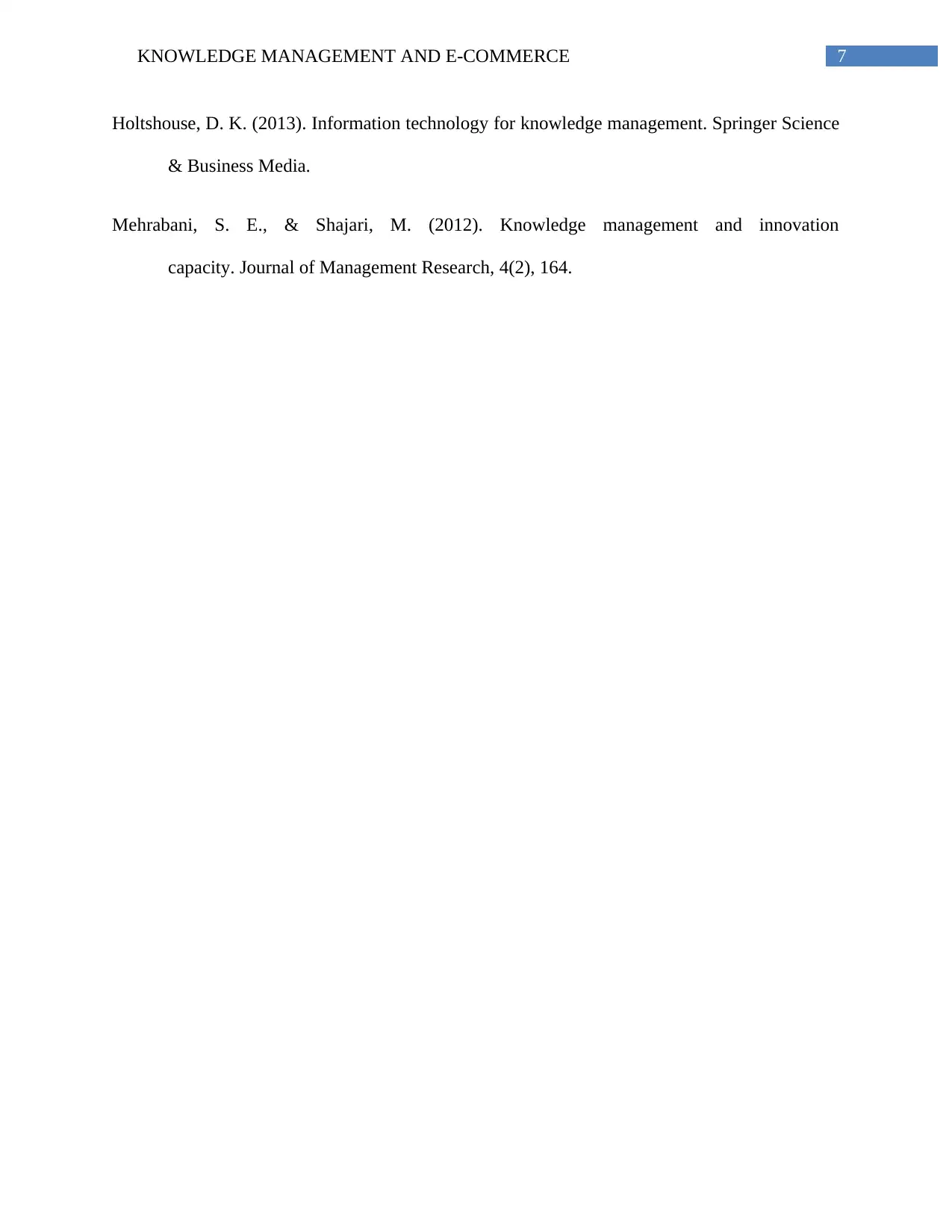
7KNOWLEDGE MANAGEMENT AND E-COMMERCE
Holtshouse, D. K. (2013). Information technology for knowledge management. Springer Science
& Business Media.
Mehrabani, S. E., & Shajari, M. (2012). Knowledge management and innovation
capacity. Journal of Management Research, 4(2), 164.
Holtshouse, D. K. (2013). Information technology for knowledge management. Springer Science
& Business Media.
Mehrabani, S. E., & Shajari, M. (2012). Knowledge management and innovation
capacity. Journal of Management Research, 4(2), 164.
1 out of 8
Related Documents
Your All-in-One AI-Powered Toolkit for Academic Success.
+13062052269
info@desklib.com
Available 24*7 on WhatsApp / Email
![[object Object]](/_next/static/media/star-bottom.7253800d.svg)
Unlock your academic potential
Copyright © 2020–2025 A2Z Services. All Rights Reserved. Developed and managed by ZUCOL.





